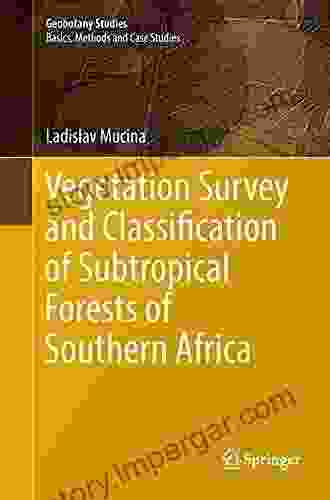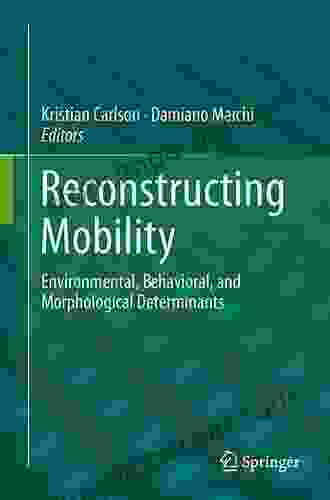Reconstructing Mobility: Environmental, Behavioral, and Morphological Determinants

Mobility is a fundamental aspect of human life, allowing us to access resources, connect with others, and experience the world around us. However, the factors that influence mobility are complex and multifaceted, involving a wide range of environmental, behavioral, and morphological determinants.
This book, "Reconstructing Mobility: Environmental, Behavioral, and Morphological Determinants," provides a comprehensive overview of these factors, offering insights for urban planning, transportation policy, and public health.
The environment in which we live plays a significant role in shaping our mobility patterns. Factors such as land use, transportation infrastructure, and the built environment all influence how we move about our communities.
4.6 out of 5
| Language | : | English |
| File size | : | 5437 KB |
| Text-to-Speech | : | Enabled |
| Enhanced typesetting | : | Enabled |
| Print length | : | 477 pages |
- Land use. The distribution of land uses within a city or region can have a major impact on mobility. For example, areas with a mix of residential, commercial, and industrial uses tend to promote walking and cycling, while areas with sprawling development patterns encourage car dependence.
- Transportation infrastructure. The availability and quality of transportation infrastructure, such as public transit, bike lanes, and sidewalks, can also influence mobility. Well-developed transportation systems make it easier for people to get around without a car, while inadequate infrastructure can create barriers to mobility.
- Built environment. The design of the built environment, including the layout of streets, buildings, and public spaces, can also affect mobility. Features such as wide sidewalks, well-lit streets, and accessible public transportation stops can make it easier for people to walk, bike, and use public transit.
In addition to environmental factors, our own behaviors also play a role in shaping our mobility patterns. Factors such as our age, income, lifestyle, and preferences all influence how we choose to travel.
- Age. Age is a major factor that influences mobility. As we get older, we tend to become less mobile, due to factors such as declining physical abilities and changes in lifestyle.
- Income. Income is another important factor that influences mobility. People with higher incomes are more likely to own cars and have access to other forms of transportation, while people with lower incomes are more likely to rely on public transit or walking.
- Lifestyle. Our lifestyle also influences our mobility patterns. People who live in urban areas tend to be more mobile than people who live in rural areas, and people who work full-time are more likely to commute than people who work part-time or are retired.
- Preferences. Our personal preferences also play a role in how we choose to travel. Some people prefer to walk or bike, while others prefer to drive or take public transit.
The morphological characteristics of our bodies also influence our mobility. Factors such as our height, weight, and physical abilities can affect how we are able to move about.
- Height. Height can affect mobility in a number of ways. For example, taller people may have difficulty fitting into cars or using public transit, while shorter people may have difficulty reaching pedals or handlebars.
- Weight. Weight can also affect mobility, as it can make it more difficult to walk or climb stairs.
- Physical abilities. Physical abilities, such as strength, balance, and coordination, can also affect mobility. People with limited physical abilities may have difficulty walking, cycling, or using public transit.
The complex interplay of environmental, behavioral, and morphological determinants makes it clear that there is no single solution to the challenge of reconstructing mobility. However, by understanding these factors, we can develop strategies to create more accessible, sustainable, and equitable communities.
This book offers a range of recommendations for reconstructing mobility, including:
- Investing in transportation infrastructure. Investing in public transit, bike lanes, and sidewalks can make it easier for people to get around without a car.
- Promoting mixed-use development. Mixed-use development can help to reduce car dependence by creating communities where people can live, work, and shop within walking distance of each other.
- Designing for accessibility. Designing buildings and public spaces with accessibility in mind can make it easier for people with disabilities to get around.
- Encouraging active transportation. Encouraging people to walk and bike can help to reduce air pollution, improve public health, and create more livable communities.
Reconstructing mobility is a complex challenge, but it is one that is essential for creating more sustainable, equitable, and livable communities. By understanding the environmental, behavioral, and morphological determinants of mobility, we can develop strategies to create communities that are accessible to everyone, regardless of age, income, or ability.
This book is a valuable resource for anyone who is interested in reconstructing mobility. It provides a comprehensive overview of the factors that influence mobility, and it offers a range of recommendations for creating more accessible, sustainable, and equitable communities.
4.6 out of 5
| Language | : | English |
| File size | : | 5437 KB |
| Text-to-Speech | : | Enabled |
| Enhanced typesetting | : | Enabled |
| Print length | : | 477 pages |
Do you want to contribute by writing guest posts on this blog?
Please contact us and send us a resume of previous articles that you have written.
 Book
Book Novel
Novel Page
Page Chapter
Chapter Text
Text Story
Story Genre
Genre Reader
Reader Library
Library Paperback
Paperback E-book
E-book Magazine
Magazine Newspaper
Newspaper Paragraph
Paragraph Sentence
Sentence Bookmark
Bookmark Shelf
Shelf Glossary
Glossary Bibliography
Bibliography Foreword
Foreword Preface
Preface Synopsis
Synopsis Annotation
Annotation Footnote
Footnote Manuscript
Manuscript Scroll
Scroll Codex
Codex Tome
Tome Bestseller
Bestseller Classics
Classics Library card
Library card Narrative
Narrative Biography
Biography Autobiography
Autobiography Memoir
Memoir Reference
Reference Encyclopedia
Encyclopedia William Szary
William Szary Matthew Mccormack
Matthew Mccormack Matt Kloskowski
Matt Kloskowski Martin Helander
Martin Helander Marcia Ballinger
Marcia Ballinger Joel Paris
Joel Paris Ralph J Diclemente
Ralph J Diclemente Christine Jacobsen
Christine Jacobsen Marti Konstant
Marti Konstant Martin Udeh
Martin Udeh Parentesi Quadra
Parentesi Quadra Marilyn Jimenez
Marilyn Jimenez Matthew C Ward
Matthew C Ward Mary C Lamia
Mary C Lamia Mark Ralkowski
Mark Ralkowski Mark Halperin
Mark Halperin Matti Friedman
Matti Friedman Martin Lindstrom
Martin Lindstrom Marco Sgarbi
Marco Sgarbi Richard M Gargiulo
Richard M Gargiulo
Light bulbAdvertise smarter! Our strategic ad space ensures maximum exposure. Reserve your spot today!

 Edgar Allan PoeAnthology of Black Humor: A Literary Odyssey into the Depths of the Absurd
Edgar Allan PoeAnthology of Black Humor: A Literary Odyssey into the Depths of the Absurd
 Dustin RichardsonStar Trek FAQ: Unofficial and Unauthorized - Your Guide to the Galaxy's...
Dustin RichardsonStar Trek FAQ: Unofficial and Unauthorized - Your Guide to the Galaxy's... Eliot FosterFollow ·16.7k
Eliot FosterFollow ·16.7k Andy ColeFollow ·2.2k
Andy ColeFollow ·2.2k Ralph TurnerFollow ·12.2k
Ralph TurnerFollow ·12.2k Wesley ReedFollow ·8.2k
Wesley ReedFollow ·8.2k Douglas FosterFollow ·16.9k
Douglas FosterFollow ·16.9k Hunter MitchellFollow ·14.8k
Hunter MitchellFollow ·14.8k Edward ReedFollow ·10.8k
Edward ReedFollow ·10.8k Nathaniel HawthorneFollow ·12.1k
Nathaniel HawthorneFollow ·12.1k

 Roberto Bolaño
Roberto BolañoUnveiling the Beauty and History of the Medici Iris: A...
In the realm of...

 Theodore Mitchell
Theodore MitchellImproving Gut Health in Poultry: Unlocking the Path to...
In the ever-evolving field of...

 Victor Hugo
Victor HugoPersonalized Medicine with a Nanochemistry Twist:...
The future of healthcare...

 George Martin
George MartinA Year Of Wine: Perfect Pairings Great Buys And What To...
## Year of Wine: An Epic Journey Through the...

 Tom Hayes
Tom HayesDelve into the Enigmatic World of Southern Africa's...
Embark on a captivating journey through the...
4.6 out of 5
| Language | : | English |
| File size | : | 5437 KB |
| Text-to-Speech | : | Enabled |
| Enhanced typesetting | : | Enabled |
| Print length | : | 477 pages |










